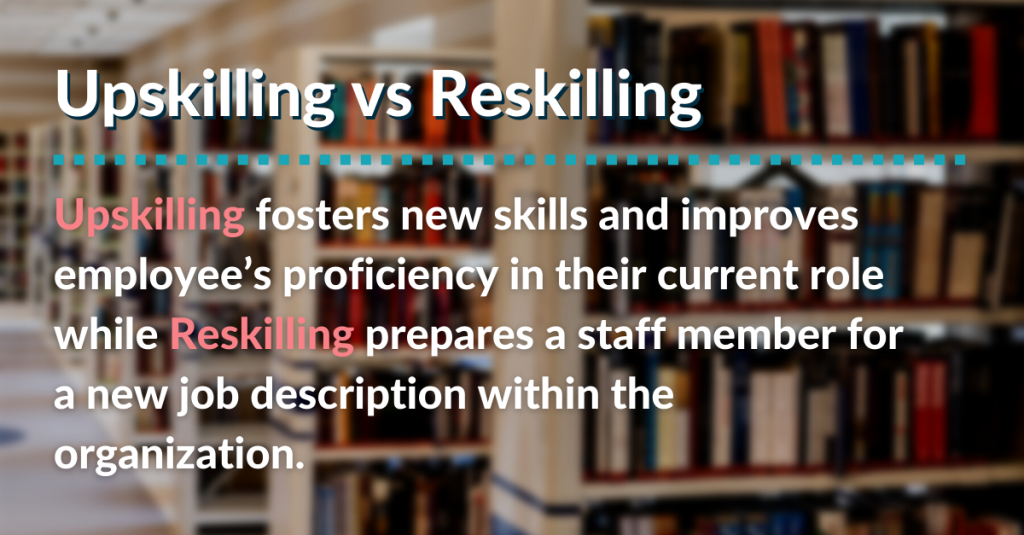If you could go back in time and read an insurance job posting from 10 or even 5 years ago and compare it to one from today, you would immediately notice that the description for the exact same job title might look significantly different. Much of this has to do with a rapidly changing workplace where the integration of technology for improved customer experience demands that employees learn new skills. Covid-19 has also driven trends in upskilling as employees adapted to remote work. But upskilling has benefits for employers beyond getting their employees comfortable with new tech or shifting work environments.
Upskilling and reskilling are essential tools for the insurance employer to identify and fill holes in their team as an alternative to facing the intensely competitive insurance hiring market. It can also shift the culture of your insurance organization and improve employee satisfaction and engagement. In this blog, we want to define upskilling, how it differs from reskilling, and how you can use these strategies to enhance your team.

In short, upskilling is the project of fostering new skills and improving employee’s proficiency in their role. Upskilling goes beyond the initial learning period that is standard for any new employee during onboarding. It is accomplished by adopting a “learning for life” mindset and a willingness to embrace new ways of doing things throughout an employee’s career or time at their organization. In other words, good upskilling never ends.
Sometimes, upskilling is a necessity of the job, such as when a new software is introduced to the company’s systems and staff must be brought up to speed. But upskilling can also be a voluntary practice initiated by corporate leaders, managers, or even the employees themselves. Upskilling is a fundamental growth step in an individual’s career path, helping them move up from their current role.
Often, upskilling and reskilling are interchangeable as they both imply some type of training or ongoing education program to increase employee competencies. Where reskilling differs is in its function to change an employee’s skill set in preparation for a lateral career shift. Rather than just improving their abilities, reskilling prepares a staff member for a new job description within the organization.
Like most of the best staffing and retention strategies, upskilling and reskilling have benefits for both the employers and their employees.
The global average “time to fill” on an open job is about 42 days, but as many insurance organizations have experienced in the last few years, that period can be much longer. Extended job vacancies can have considerable monetary costs for companies and can put stress on existing employees to maintain productivity and output with less manpower.

It’s no secret that finding new recruits with the right skillset for an insurance role is increasingly difficult. Many experienced insurance professionals are nearing retirement or are already locked into high level positions. The hiring pool is so often full of inexperienced candidates, and while we encourage evaluating beyond the resume, preparing to upskill new employees or reskill current staff can protect you from the trials and tribulations of the hiring market.
To best leverage upskilling and reskilling in your organization, you need to do some advance planning. Time to take a step back, set a meeting for upper management, and whip out a calendar for the upcoming year.
Before you launch into conference tickets, online classes, and in-person seminars, you need to evaluate what your workforce needs are. Are there services you wish you could offer–or an added level of depth–to clients that your team can’t fulfill with their current skill set? Is there a position on your team that has been vacant for an extended period of time? Are there industry trends you would like to keep up to date with? And on the individual level, are there employees you can identify whose skills need to be further developed to reach maximum productivity in their role?
Often, your team has a lot they can teach one another. An internal upskilling strategy leverages the existing strengths of different individuals. Employees may even be more receptive to new information when it comes from a familiar source. Consider whether the skill gaps you identified in step one could be fulfilled through internal resources.
There are hundreds of companies whose sole purpose is to provide training as a paid service. If there are skills that can’t be learned internally or for which you want an outside perspective, hire an external institution or individual to provide upskilling.
Upskilling can happen through lots of different educational pathways. It’s important to remember that not every method will work equally well for every employee. Often, to achieve the best results, your upskilling strategy needs to be tailored to individuals. Here are a few different avenues for learning that you can explore:

Unless you formalize upskilling as part of your company’s goals with a solid schedule to reach them, educational tasks can often fall to the wayside. The work ahead of your team is important and it can be difficult to set aside time for ‘extracurriculars’ like upskilling. Treat professional development as part of your employee’s job description and ensure that you are providing the time, space, and resources for them to complete it. Check in with your staff members along the way to re-evaluate where more training is needed and ensure they’re getting the support they need.
Upskilling has the potential to help your organization avoid sticky hiring situations down the line but you’ll need some advance planning to tap into it. With the right education systems in place, you can begin to predict where future needs will arise. Is there a high level staff member who may be nearing retirement in the next 5-10 years? Is your organization hoping to grow and will therefore be in need of more managers to support a young staff. We could spend an entire other blog discussing succession planning, but understand that with the right forecasting, your existing team has the power to fill a lot of needs that may arise down the road.
One of the additional benefits of going through this 5 step process is that it will also help you identify when upskilling employees isn’t enough to get your company to its goals. Sometimes new staff with a uniquely developed skill set is necessary to grow your insurance organization. But we know hiring can be nerve wracking, which is why we’ve spent more than 50 years developing our skills as recruiters exclusively for the insurance industry. If you’re looking to add to your team and need help finding candidates with the right skills, reach out to us to start a conversation about how we can help!